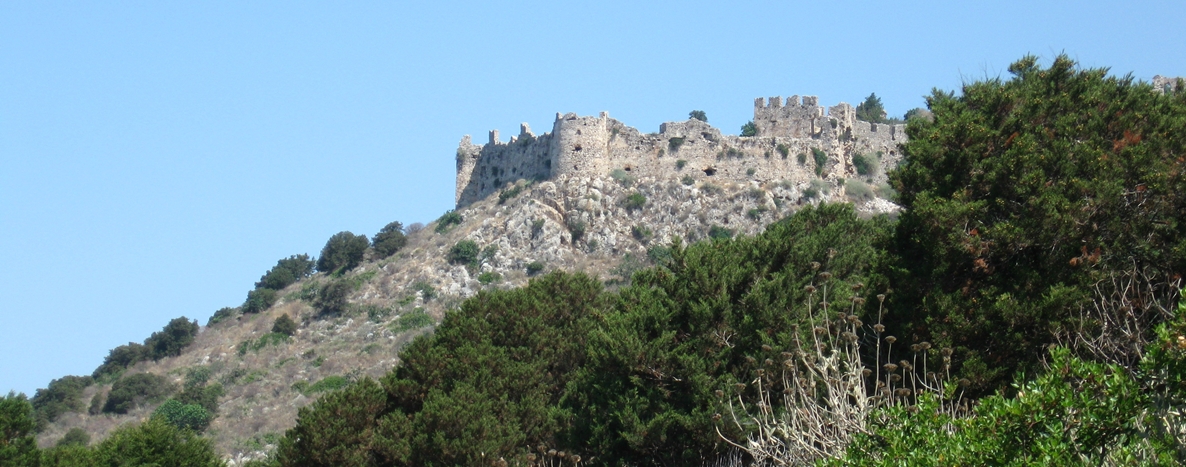PALEOKASTRO

Paleokastro at Pylos
PLEASE NOTE THAT ALL THE PHOTOGRAPHS ON THE SITE ARE CLICKABLE LINKS

PLEASE NOTE THAT ALL THE PHOTOGRAPHS ON THE SITE ARE CLICKABLE LINKS
Paleokastro or Palionavarino is a medieval castle and an ancient acropolis, on top of a steep cliff overlooking the Gialova lagoon, on the north side of the bay of Navarino.
The ancient acropolis of Pylos was at the same location. This was not the Pylos of Nestor and of the epic poems of Homer, but the Pylos of the classic period which played a role in the Peloponnesian war.
The medieval castle was built in 1278 by Nicholas II of Saint Omer the French feudal ruler of Thebes, who had become Baron of Kalamata after his marriage to Angelina Komnene, widow of the Prince of Achaea Guillaume II de Villehardouin. The initial name of the castle was Port de Jonc (Bulrush Port).
In 1366, Mary of the Bourbons fled in the castle where she was besieged by the Franks under the Venetian priest (later a general) Carlo Jeno. The war, however, stopped and the siege was resolved.
In 1381, the castle was occupied by the Navarrese, which was a company of mercenaries, mostly from Navarre and Gascony, which fought in Greece during the late 14th century and early 15th century, in the twilight of Frankish power in Peloponnese.
In 1423 the castle was bought by the Venetians in order to enhance the protection to the north of their possessions in the area, namely the castles of Methoni and Koroni .
In 1500, the Ottoman sultan Bayezid II conquered and destroyed the castle of Methoni. After that, Paleokastro surrendered without a fight to avoid the fate of Methoni.
In 1573, after the naval battle of Lepanto, the Turks started the construction of a new castle in Pylos. To distinguish the two castles located on both ends of the Bay of Navarino, the old one was named Paleokastro (old castle) and the new one Niokastro (new castle). Paleokastro started to decline after that, in favor of Niokastro.
In 1668 the Turkish traveler Evlia Celebi passed from Messinia and found in Paleokastro 80 stone tiled roof houses with vineyards and orchards, 1 mosque, 5 shops, an inn, a Turkish bath and a medrese.
In 1686 the Venetian commander Morosini occupied the two castles of the Navarino Bay after a siege and launched the Second Venetian Occupation of Peloponnese which lasted until 1715. In 1715 the Turks returned.
In 1821, in the first days of the Greek Revolution, the Greeks occupied Paleokastro. In 1825, Ibrahim pasha landed at Methoni and crashed a Greek army near the village Kremmydi. After that battle, 200 Greek fighters rushed and found refuge in Paleokastro.
Ibrahim besieged the castle. Without water and supplies, the Greeks capitulated on 28th April 1825.
On 20 October 1827 Paleokastro took part in one of the most important naval battles of the world history, the battle of Navarino. The Turkish canons were shooting against the ships of the European allies from Paleokastro (as well as from Niokastro).
The castle has undergone many modifications and reconstructions through the centuries.
Its shape is a trapezoid and the total area around 50,000 sq m. The walls and many of its towers are still standing but inside there are only ruins.
The interior of the castle is separated by a transverse wall in two parts: the north and the south. The north part, which is at the top, is the location of the ancient acropolis and probably the location of the initial Frankish castle.
The south yard was added much later by the Venetians or the Turks. The preserved form of the castle is the result of the final changes in the late 16th century.
On the east side there are no walls, as the natural fortification of the rock provided sufficient protection.
Although there are no physical barriers to access, the castle ruins have been declared "closed" because the structure is considered dangerous.
Below the walls of the castle there is the so called "Cave of Nestor". According to the Greek Mythology, Hermes hid in this cave the cows that he had stolen from god Apollo.